

Palaris Revolt. The Palaris Revolt of 1762-1765 was led by Juan de la Cruz Palaris, also known as Pantaleon Perez, of Binalatongan (now San Carlos City).[1] He was the son to Tomas Perez, a cabeza de barangay.
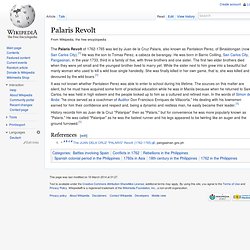
He was born in Barrio Coliling, San Carlos City, Pangasinan, in the year 1733, third in a family of five, with three brothers and one sister. The first two elder brothers died when they were yet small and the youngest brother lived to marry yet. While the sister next to him grew into a beautiful but manly woman who used to kill a wild boar single handedly. She was finally killed in her own game, that is, she was killed and devoured by the wild boars.[1] It was not known whether Pantaleon Perez was able to enter to school during his lifetime. History records him as Juan de la Cruz "Palaripar" then as "Palaris," but for convenience he was more popularly known as "Palaris.
" The New York Times/Mr. Schurz's Plea for Aguinaldo. Mr.
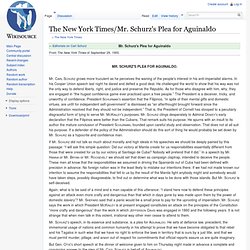
Carl Schurz grows more truculent as he perceives the waning of the people's interest in his anti-imperialist alarms. In his Cooper Union speech last night he dared and defied a good deal. He challenged the world to show that his way was not the only way to defend liberty, right, and justice and preserve the Republic. As for those who disagree with him, why, they are engaged in “the hugest confidence game ever practiced upon a free people.” EDSA Revolution of 2001. EDSA Shrine The 2001 EDSA Revolution, also known as EDSA II (pronounced "EHD-sa Dos"), was a four-day political protest from 17-20 January 2001 that peacefully overthrew the government of Joseph Estrada, the tenth President of the Philippines.
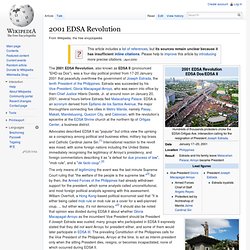
Estrada was succeeded by his Vice-President, Gloria Macapagal-Arroyo, who was sworn into office by then-Chief Justice Hilario Davide, Jr. at around noon on January 20, 2001, several hours before Estrada fled Malacañang Palace. Epifanio de los Santos Avenue. Epifanio de los Santos Avenue (Filipino/Spanish: Avenida Epifanio de los Santos), commonly referred to by its acronym EDSA, is a limited-access circumferential freeway around Manila, the capital of the Philippines.
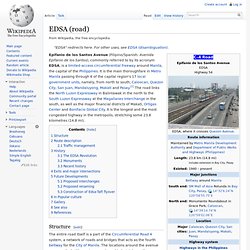
Sakdalista. The Philippine Sakdalista (coming from the Tagalog word sakdal, meaning "to accuse") movement was founded in 1930 by right wing leader Benigno Ramos, a writer and discontented former government clerk.
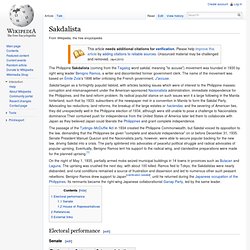
The name of the movement was based on Émile Zola's 1898 letter criticising the French government, J'accuse. Sakdal began as a fortnightly populist tabloid, with articles tackling issues which were of interest to the Philippine masses: corruption and mismanagement under the American-sponsored Nacionalista administration, immediate independence for the Philippines, and the land reform problem. Its radical populist stance on such issues won it a large following in the Manila hinterland, such that by 1933, subscribers of the newspaper met in a convention in Manila to form the Sakdal Party. Electoral performance[edit] Senate[edit] Philippine History: Marcos Era and Martial Law (1965 - 1986)
Philippine–American War. The Philippine–American War (Filipino(Tagalog): Digmaang Pilipino-Amerikano) (1899–1902),[12] was an armed conflict between the United States and Filipino revolutionaries.
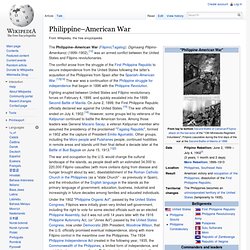
The conflict arose from the struggle of the First Philippine Republic to secure independence from the United States following the latter's acquisition of the Philippines from Spain after the Spanish–American War.[13][14] The war was a continuation of the Philippine struggle for independence that began in 1896 with the Philippine Revolution. Nomenclature[edit] Balangiga massacre. The Balangiga massacre[5] was an incident in 1901 in the town of the same name during the Philippine–American War.
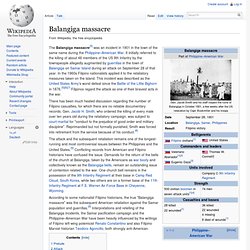
It initially referred to the killing of about 48 members of the US 9th Infantry by the townspeople allegedly augmented by guerrillas in the town of Balangiga on Samar Island during an attack on September 28 of that year. In the 1960s Filipino nationalists applied it to the retaliatory measures taken on the island. This incident was described as the United States Army's worst defeat since the Battle of the Little Bighorn in 1876.[5][6][7] Filipinos regard the attack as one of their bravest acts in the war. There has been much heated discussion regarding the number of Filipino casualties, for which there are no reliable documentary records. Gen. Prelude[edit] Bell Trade Act. The Bell Trade Act' of 1946, also known as the Philippine Trade Act, was an act passed by the United States Congress specifying the economic conditions governing the independence of the Philippines from the United States.[1][2] The United States Congress offered $800 million for post World War II rebuilding funds if the Bell Trade Act was ratified by Philippine legislature, which duly approved the measure on July 2, two days before independence from the United States of America.

Authored by Missouri Congressman C. Commonwealth of the Philippines. The Commonwealth of the Philippines (Tagalog: Komonwelt ng Pilipinas) was the administrative body that governed the Philippines from 1935 to 1946, aside from a period of exile in the Second World War from 1942 to 1945 when Japan occupied the country.
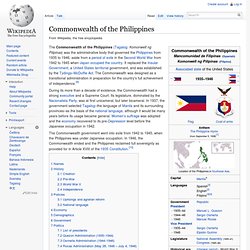
It replaced the Insular Government, a United States territorial government, and was established by the Tydings–McDuffie Act. The Commonwealth was designed as a transitional administration in preparation for the country's full achievement of independence.[9] The Commonwealth government went into exile from 1942 to 1945, when the Philippines was under Japanese occupation. In 1946, the Commonwealth ended and the Philippines reclaimed full sovereignty as provided for in Article XVIII of the 1935 Constitution.[10] Names[edit]
Cry of Pugad Lawin. List of Katipunan Members present in Balintawak on August 1896 by Guillermo Masangkay The Cry of Pugad Lawin (Filipino: Sigaw ng Pugad Lawin), alternately and originally referred to as the Cry of Balintawak (Filipino: Sigaw ng Balintawak, Spanish: Grito de Balintawak) was the beginning of the Philippine Revolution against Spanish rule.[1] At the close of August 1896, members of the Katipunan secret society (Katipuneros) led by Andres Bonifacio rose up in revolt somewhere in an area referred to as Kalookan, wider than the jurisdiction of present-day Caloocan City and overlapping into present-day Quezon City.[2]
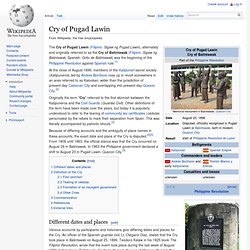
Negros Revolution. The Negros Revolution, now commemorated and popularly known as Al Cinco de Noviembre or Negros Day, was a political movement that in 1898 created a government in Negros Island in the Philippines, informally ending Spanish control of the island and resulting in a government run by the Negrense natives, at least for that part of the archipelago and for a relatively short period. The newly established Negros Republic would last for approximately three months. American forces landed on the island unopposed on February 2, 1899, ending the island's independence.
Prelude to revolution[edit] Republic of Negros. The Republic of Negros (Spanish: República de Negros, Hiligaynon: Republica sang Negros) was a short-lived revolutionary republic, and later, administrative division, which existed while the Philippines was under Spanish and American sovereignty. It took its name from Negros Island. History[edit] From 3 November to 6 November 1898, the people of Negros rose in revolt against the Spanish authorities headed by politico-military governor Colonel Isidro de Castro.
The Spaniards decided to surrender upon seeing armed troops marching in a pincer movement towards Bacolod. Babaylan. Babaylan is a Visayan term identifying an indigenous Filipino religious leader, who functions as a healer, a shaman, a seer and a community "miracle-worker" (or a combination of any of those). The babaylan can be male, female, or male transvestites (known as asog, bayoc, or bayog), but most of the babaylan were female. The babaylan in Filipino indigenous tradition is a person who is gifted to heal the spirit and the body; a woman who serves the community through her role as a folk therapist, wisdom-keeper and philosopher; a woman who provides stability to the community’s social structure; a woman who can access the spirit realm and other states of consciousness and traffic easily in and out of these worlds; a woman who has vast knowledge of healing therapies".
—Leny Strobel A babaylan is "a specialist in the fields of culture, religion, medicine and all kinds of theoretical knowledge about the phenomenon of nature. See also[edit] References[edit] Dagohoy Rebellion. The famous Dagohoy Rebellion, also known as Dagohoy Revolution or Dagohoy Revolt, is considered as the longest rebellion in Philippine history. Led by Francisco Dagohoy, also known as Francisco Sendrijas, this rebellion took place in the island of Bohol from 1744 to 1829,[1] roughly 85 years. It was one of two significant revolts that occurred in Bohol, Philippines during the Spanish Era. The other one was the Tamblot Uprising in 1621 led by Tamblot, a babaylan or native priest from Bohol which was basically a religious conflict.[2]
Kingdom of Namayan. The ancient Kingdom of Namayan (also called the Kingdom of Sapa, Maysapan or Nasapan,[1] and sometimes Lamayan - both references to its capital) was one of three major kingdoms that dominated the banks of the Pasig River and the coast of Laguna de Bay in the Philippines prior to the Spanish conquest in the 16th century. Namayan is said to be the oldest of the three kingdoms, predating the kingdoms of Tondo and Maynila.
Formed by a confederation of barangays, it is said to have achieved its peak in 1175.[3] Historical record[edit] Much of what is known about precolonial Namayan is based on "Estado Geográfico, Topográfico, Estadístico, Histórico-Religioso de la Santa y Apostólica Província de San Gregorio Magno", published in 1865 by Franciscan scholar Fr. Felix de Huerta. Capital Sites[edit] Three present-day locations are identified as the political centres of Namayan. Sapa[edit] Sapa is the Modern Tagalog word for a small creek. Lamayan[edit] Greater India. Dark orange: The Indian subcontinent. Light orange: Other countries culturally linked to India, notably Burma, Thailand, Cambodia, Laos, Champa (Historically consisted of Southern Vietnam), Indonesia, Malaysia, Brunei and Singapore.
Yellow: Regions with significant Indian cultural influence, notably Afghanistan, Tibet, China's Yunnan Province and the Philippines. Confederation of Madya-as. Kingdom of Tondo. Battle of Bankusay Channel. The Battle of Bankusay on June 3, 1571 marked the last resistance to the occupation of Manila by the Spaniards, led by Miguel López de Legazpi. Tarik Sulayman, the chief of Macabebe, Pampanga, refusing to ally with the Spanish as Lakandula of Tondo had done, decided to mount an attack at Bankusay Channel. His forces were defeated, and he himself was killed. The Spanish victory at Bankusay and Legaspi's friendship with Lakandula, enabled the Spaniards to establish themselves throughout the city and its neighboring towns. Background[edit] Miguel López de Legazpi, searching for a suitable place to establish his capital after being compelled to move from Cebu to Panay by Portuguese pirates and imminent famine under Martin de Goiti and Captain Juan de Salcedo to discover the location and potentials of a sultanate in Luzon.
In 1571, the Spaniards returned with their entire force (consisting of 280 Spaniards and 600 native allies), this time led by Legazpi himself. British occupation of Manila. First Philippine Republic. Philippine Revolution. People Power Revolution. Background and history[edit] Ferdinand Marcos was elected president in 1965, defeating incumbent Diosdado Macapagal by a very slim margin. Timeline of Philippine history. This is a timeline of Philippine history, comprising important legal and territorial changes and political events in the Philippines and their predecessor states.
Philippine revolts against Spain. 16th century[edit] Dagami Revolt (1565-1567)[edit] Conspiracy of the Maharlikas. Moro National Liberation Front. New People's Army.